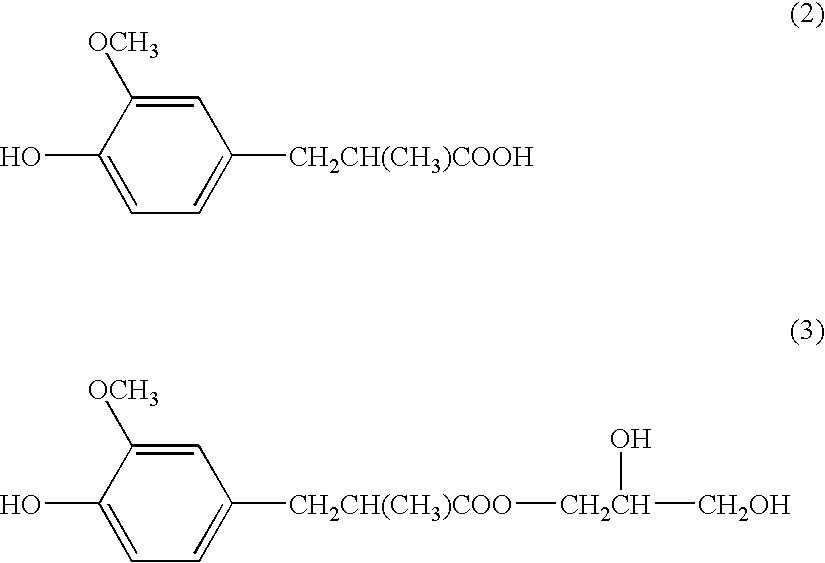Functional additive having UV-absorbing substituent and ink composition containing the same
a technology of ink composition and additive, which is applied in the direction of inks, chemical inhibitors, group 5/15 element organic compounds, etc., can solve the problems of color images printed using ink compositions with poor light resistance, deterioration and yellowing of printing media, and prone to bleaching or discoloration, etc., to achieve the effect of stabilizing a colorant and enhancing light resistan
- Summary
- Abstract
- Description
- Claims
- Application Information
AI Technical Summary
Benefits of technology
Problems solved by technology
Method used
Image
Examples
synthetic example 1
[0048](1) 100 mL of chloroform was placed into a 250-mL round-bottomed flask and bubbled while supplying a HCl gas for 1–2 hours, and 29.5 g of 2-methoxy-4-(2-propenyl)phenol was added to the flask and refluxed for 6 hours or longer. 16.6 g of NaCN was added to the reaction solution and reacted at 80° C. for 8 hours or longer to extract the organic phase. The organic phase was concentrated to obtain 37.5 g of a crystalline compound A.
[0049](2) 30.6 g of the crystalline compound (A) was dissolved in 500 mL of a 1:1 mixture of water and methanol. 30 mL of concentrated sulfuric acid were slowly added together with one or two boiling chips into the mixture and refluxed for 10 hours or longer. The reaction solution was cooled to room temperature, and excess distilled water was added to precipitate a crystalline compound (B). The crystalline compound (B) was collected using a suction filter and was dried in an oven to provide 23.5 g of a compound of formula (2) below.
[0050](3) 18.8 g of t...
synthesis example 2
[0052](1) 73.4 g of 2-methoxy-4-(2-propenyl)phenol was fully dissolved in 200 mL of dimethyl acetamide (DMAC) contained in a 500-mL Erlenmeyer flask. 74.2 g of perbenzoic acid was added to the solution and reacted at 80° C. for 12 hours or longer. The reaction solution was cooled to room temperature, and excess distilled water was added to precipitate a crystalline compound (C). The crystalline compound (C) was collected using a suction filter and dried in an oven to provide 57.2 g of epoxide.
[0053](2) 9.9 g of ethylene glycol was added to, and thoroughly mixed with, 100 mL of DMSO contained in a 250-mL Erlenmeyer flask. 21.9 g of the epoxide was added to and dissolved in the mixture, reacted 80° C. for 8 hours or longer, and cooled to room temperature. Excess distilled water was added to the solution to precipitate a crystalline compound. This crystalline compound was collected using a suction filter and dried in an oven to provide 17.6 g of a compound of formula (4) below.
[0054]
synthesis example 3
[0055]15.22 g of 4-ethyl-2-methoxyphenol was reacted with Cl2 in the presence of a photocatalyst and then reacted with 6.21 g of ethylene glycol in the presence of a base to provide 14.86 g of a compound of formula (5) below.
[0056]
PUM
| Property | Measurement | Unit |
|---|---|---|
| temperature | aaaaa | aaaaa |
| black color | aaaaa | aaaaa |
| weight | aaaaa | aaaaa |
Abstract
Description
Claims
Application Information
 Login to View More
Login to View More - R&D
- Intellectual Property
- Life Sciences
- Materials
- Tech Scout
- Unparalleled Data Quality
- Higher Quality Content
- 60% Fewer Hallucinations
Browse by: Latest US Patents, China's latest patents, Technical Efficacy Thesaurus, Application Domain, Technology Topic, Popular Technical Reports.
© 2025 PatSnap. All rights reserved.Legal|Privacy policy|Modern Slavery Act Transparency Statement|Sitemap|About US| Contact US: help@patsnap.com



